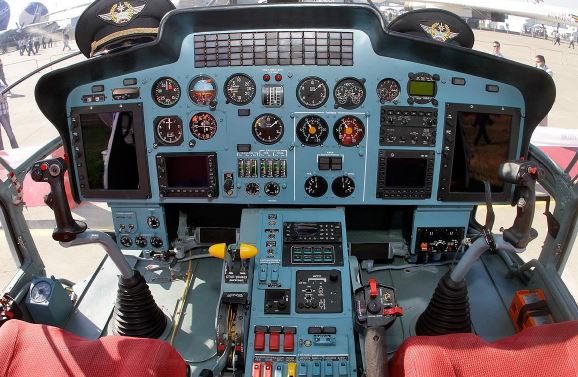Kamov Ka-31 Helix Specs, Radar, Cockpit, and Price – Kamov Ka-31 (NATO reporting name: Helix) is an Airborne Early Warning (AEW) helicopter designed to protect warship units operating outside coastal radar and ERW (Early Radar Warning) aircraft coverage against air strikes. Kamov JSC, based in Moscow, began development of the Ka-31 helicopter in 1980 and the first flight took place in 1987.
The main mission of the Ka-31 helicopter is to detect long-term threats, including air threats such as fixed wing aircraft and helicopters. Monitoring, tracking targets, and transmitting target data to the command post is carried out on a helicopter. The initial provision of hostile target information increases the efficiency of naval combat, air defense and ground forces. This can be used both on ships and on land.

Ka-31 helicopter has a maximum take-off weight of 12,200 kg. Operating height up to 3,500 m. The helicopter flies with patrol at a speed of 100 km / h and the operational range with the antenna at the stored position is 600 km. The duration of the mission is two hours 30 minutes.
Power for radars and antennas is provided by additional power units, the TA-8Ka type, mounted above the rear of the engine compartment. Flight recorder mounted on the tailcone fairing.

The Ka-31 navigation suite includes a 12-channel Kronstadt Kabris global positioning system, digital terrain mapping, close range warning and barrier approach warnings.

The navigator activates the elongated radar and antenna system, rotating 90 ° from horizontal to the vertical plane. In operation, the antenna rotates at 6 rpm. After the navigator changes the radar system to operational mode, the system works autonomously without operator control. The navigator monitors the target's observation on the screen.
When the radar surveillance phase of the mission is complete, the antenna is pulled to the storage position. The antenna is equipped with explosive bolts which allow it to be disposed of quickly in an emergency, such as in the preparation of a forced landing.
The main mission of the Ka-31 helicopter is to detect long-term threats, including air threats such as fixed wing aircraft and helicopters. Monitoring, tracking targets, and transmitting target data to the command post is carried out on a helicopter. The initial provision of hostile target information increases the efficiency of naval combat, air defense and ground forces. This can be used both on ships and on land.

Kamov Ka-31 Helix Specs
The Ka-31 helicopter is equipped with a counter-rotation main rotor. The Ka-31 airframe is based on a proven and very successful Ka-27. A visual characteristic of the Ka-31 is the large antenna of the early warning radar, which can be rotated or folded and stored under the fuselage. This helicopter is also equipped with a reverse landing gear to prevent interference with radar. Overall, the Ka-31 helicopter is 12.5 m long and 5.6 m high.Ka-31 helicopter has a maximum take-off weight of 12,200 kg. Operating height up to 3,500 m. The helicopter flies with patrol at a speed of 100 km / h and the operational range with the antenna at the stored position is 600 km. The duration of the mission is two hours 30 minutes.
Kamov Ka-31 Helix Engine
The Ka-31 helicopter is powered by two Klimov TV3-117VMAR turboshaft engines. Each engine produces power of 1,633 kW. The fuel tank is filled with a low pressure, fire suppressing polyurethane foam material to prevent an explosion and reduce fuel loss if there is severe damage during a battle.Power for radars and antennas is provided by additional power units, the TA-8Ka type, mounted above the rear of the engine compartment. Flight recorder mounted on the tailcone fairing.

Kamov Ka-31 Helix Cockpit and Avionics
The Ka-31 helicopter's cockpit is wider than the Ka-27 helicopter and can accommodate two crew members, a pilot and a navigator. The cockpit is equipped with a system of self-protection from threats.The Ka-31 navigation suite includes a 12-channel Kronstadt Kabris global positioning system, digital terrain mapping, close range warning and barrier approach warnings.

Kamov Ka-31 Helix Radar
The early warning radar integrated on the Ka-31 helicopter is the E-801M Oko (Eye), developed by the Nizhny Novgorod Radio Engineering Institute. The 6 m² radar antenna is placed flat at the bottom of the fuselage until it is deployed. Radar has a 360 ° azimuth coverage. The range of surveillance of the target size of the fighter aircraft reached 150 km. The range of supervision of surface vessels is usually 100 km to 200 km. This radar is able to track 40 targets simultaneously.The navigator activates the elongated radar and antenna system, rotating 90 ° from horizontal to the vertical plane. In operation, the antenna rotates at 6 rpm. After the navigator changes the radar system to operational mode, the system works autonomously without operator control. The navigator monitors the target's observation on the screen.
When the radar surveillance phase of the mission is complete, the antenna is pulled to the storage position. The antenna is equipped with explosive bolts which allow it to be disposed of quickly in an emergency, such as in the preparation of a forced landing.
Kamov Ka-31 Helix Price and Orders
The latest Kamov Ka-31 Airborne Early Warning (AEW) helicopter is US $ 29 Million. The Indian Navy ordered four Ka-31 AEW radar picket helicopters in 1999 and five more in 2001. Full-scale production of helicopters began in 2002. The first batch of four entered service with the Indian Navy in April 2003. The second wave was sent in 2005. Ka-31 will also operate from the original Indian Navy aircraft carrier, which is scheduled to begin construction at the end of 2007.
Kamov Ka-31 Helix Specs, Radar, Cockpit, and Price
 Reviewed by Admin
on
01:00
Rating:
Reviewed by Admin
on
01:00
Rating:
 Reviewed by Admin
on
01:00
Rating:
Reviewed by Admin
on
01:00
Rating:






No comments: